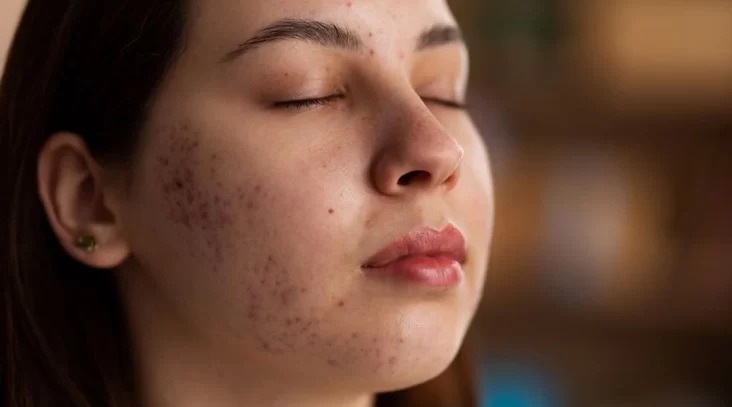Hyperpigmentation, or dark spots on the skin, is caused by an excess of melanin. Melanin is responsible for the colour of the eyes, skin, and hair.
Although people may decide to have dark spots on their skin removed for cosmetic purposes, they are not a reason for concern or therapy. Certain dark areas on the skin might be referred to as sunspots or age spots, depending on the underlying reason.
In this article, we will look at what causes black spots on the skin and how to get rid of dark spots using dermatological treatments and home remedies.
Symptoms of dark spots
Skin pigmentation can vary in colour from pale to deep brown. The skin tone of an individual might affect the colour of dark spots. The patches have the same texture as the skin and are painless.
Dark spots can appear on any part of the body and come in all sizes, although they are more prevalent in locations that are frequently exposed to sunlight.
Dark patches are typical in the following locations:
- back of the hands
- face
- back
- shoulders
In those with darker complexion, a patch that is a few shades darker than the skin normally fades away within 6 to 12 months. It can take years for deeper colouring to vanish. Deep colour shifts typically have a blue or grey appearance, while they can also be significantly darker brown than the person’s normal skin tone.
Causes of dark spots
As we describe below, there are various distinct causes of dark spots.
Sun damage
After being exposed to the sun or tanning beds, people might develop black patches on their skin, often known as sunspots, solar lentigines, or liver spots.
Sun spots are most likely to appear on the face, hands, or arms—areas of the body that are exposed to the most sun.
Hormonal changes
A skin ailment called melasma causes minor skin discolorations in spots. Women are more likely to get the illness, particularly when they are pregnant.
The American Academy of Dermatology states that hormones may be the cause of melasma.
Medication side effects
Dark patches might result from certain drugs that increase skin pigmentation. Tetracyclines, psychiatric medications, and non-steroidal anti-inflammatory medicines (NSAIDs) are the most frequently found offenders.
Inflammation
Following an episode of skin inflammation, dark spots may appear on the skin. Numerous conditions, such as eczema, psoriasis, skin injuries, and acne, can cause inflammation.
Wound healing
After a burn, cut, or insect bite, dark patches could still be visible. With time, these might vanish.
Irritation
Dark patches can appear on the skin as a result of irritation from cosmetic skin or hair products.
Diabetes
Darkening of certain skin patches might be a symptom of diabetes.
Diabetes-related disorders include diabetic dermopathy, sometimes known as shin spots, and acanthosis nigricans, which results in velvety, darkened skin that some people mistake for age spots.
How to remove dark spots
Although there is no need for treatment for dark spots on the skin, some people may wish to have the spots removed for aesthetic purposes.
A dermatologist can recommend treatments or lotions to lessen or, in certain situations, completely erase dark patches. Although they usually work faster, procedures are more costly than creams and have a higher chance of unwanted effects.
The cause, the size of the black spot, and the location on the body may all influence the best course of action.
For skin dark patches, a dermatologist might suggest one of the following treatments:
Laser treatment
There are various kinds of lasers available. An strong pulse light laser is used in the most popular laser procedure to cure black spots on the skin. Melanin is the target of light, which disperses the dark areas.
Microdermabrasion
A dermatologist uses a specialised tool with an abrasive surface during microdermabrasion to remove the skin’s outer layer. This process promotes the synthesis of new collagen, which may reduce spots.
Chemical peels
During a chemical peel, a solution is applied to the skin, causing the skin’s surface to exfoliate and encouraging the formation of new skin. It could progressively lighten skin discolorations.
Cryotherapy
The process known as cryotherapy involves freezing the dark areas on the skin by applying liquid nitrogen, which damages the skin cells. After healing, the skin generally becomes lighter.
Prescription skin-lightening cream
Bleaching the skin is how prescription lightening creams function. Dark patches usually emerge less frequently after several months of progressive improvement.
The active component of the lotions, hydroquinone, stops the skin from making melanin. Prescription goods typically have a 3–4% strength.
Although there are injectable skin-lightening solutions on the market, the FDA (FDA)Trusted Source does not advise using them. It is not clear from the research that they are effective, and there might be negative health effects.
Hyperpigmentation, or dark spots on the skin, can result from a variety of factors. They typically don’t require medical attention and are safe. A person can try a variety of treatments on how to get rid of black spots, such as utilising over-the-counter medications or consulting our dermatologist at Sujata Birla Hospital for cosmetic operations.
The reason and severity of the dark patches may affect how well a treatment works. Skin dark patches could not go away entirely. While it could take some time to notice an improvement, therapy frequently makes the spots lighter.


One Comment
Pingback: How to get rid of dark spots – Sujata Birla Hospital